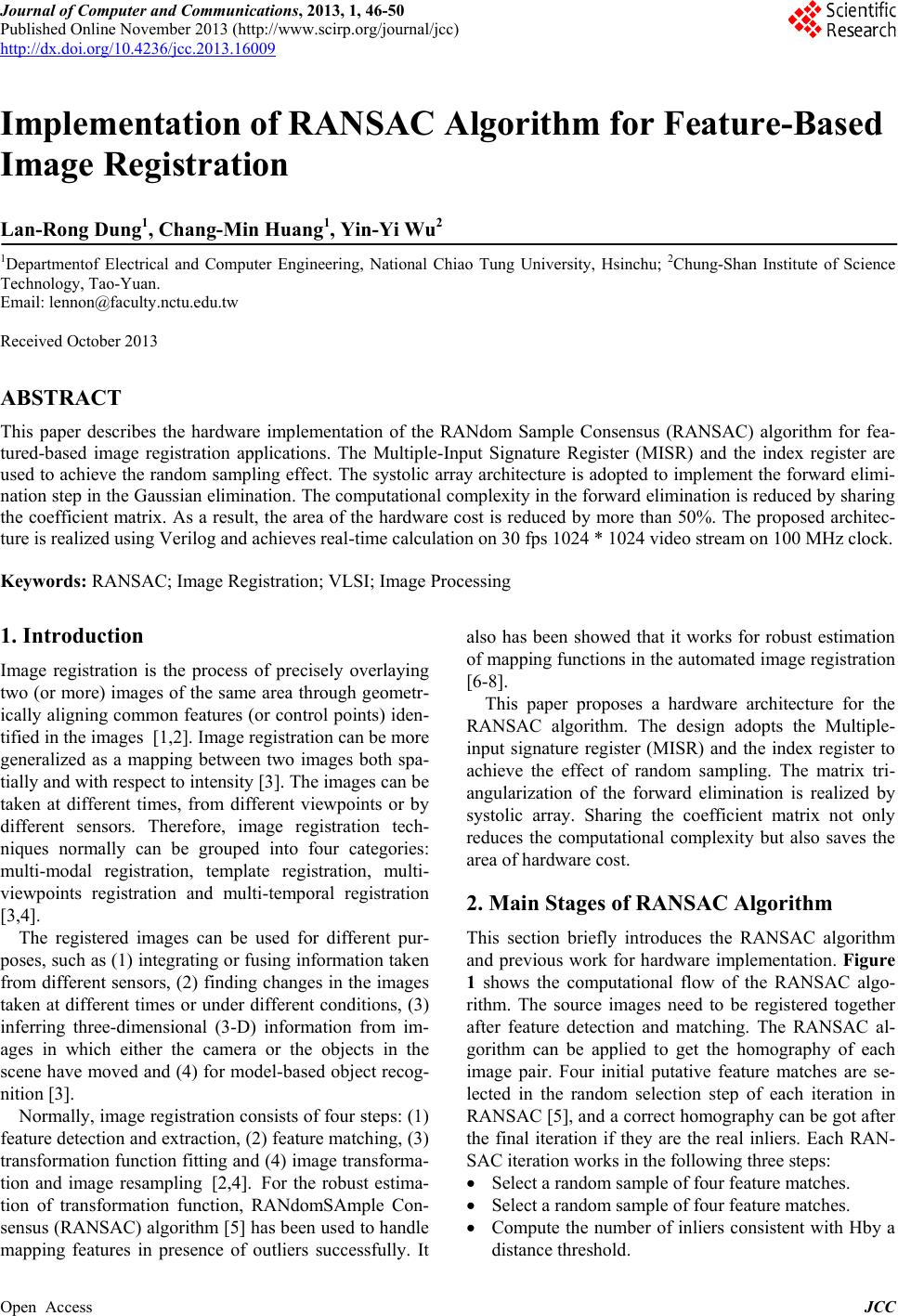
Journal of Computer and Communications, 2013, 1, 46-50
Published Online November 2013 (http://www.scirp.org/journal/jcc)
http://dx.doi.org/10.4236/jcc.2013.16009
Open Access JCC
Implementation of RANSAC Algorithm for Feature-Based
Image Registr ati on
Lan-Rong Dung1, Chang-Min Huang1, Yin-Yi Wu2
1Departmentof Electrical and Computer Engineering, National Chiao Tung University, Hsinchu; 2Chung-Shan Institute of Science
Technology, Tao-Yuan.
Email: lennon@faculty.nctu.edu.tw
Received October 2013
ABSTRACT
This paper describes the hardware implementation of the RANdom Sample Consensus (RANSAC) algorithm for fea-
tured-based image registration applications. The Multiple-Input Signature Register (MISR) and the index register are
used to achieve the random sampling effect. The systolic array architecture is adopted to implement the forward elimi-
nation step in the Gaussian elimination. The computational complexity in the forward elimination is reduced by sharing
the coefficient matrix. As a result, the area of the hardware cost is reduced by more than 50%. The proposed architec-
ture is realized using Verilog and achieves real-time calculation on 30 fps 1024 * 1024 video strea m on 100 MHz clock.
Keywords: RANSAC; Image Registration; VLSI; Image Processing
1. Introduction
Image registration is the process of precisely overlaying
two (or more) images of the same area through geometr-
ically aligning common features (or control points) iden-
tified in the images [1,2]. Image registration can be more
generalized as a mapping between two images both spa-
tially and with respect to intensity [3]. Th e images can be
taken at different times, from different viewpoints or by
different sensors. Therefore, image registration tech-
niques normally can be grouped into four categories:
multi-modal registration, template registration, multi-
viewpoints registration and multi-temporal registration
[3,4].
The registered images can be used for different pur-
poses, such as (1) integrating or fusing information taken
from different sensors, (2) finding changes in the images
taken at different times or under different conditions, (3)
inferring three-dimensional (3-D) information from im-
ages in which either the camera or the objects in the
scene have moved and (4) for model-based object recog-
nition [ 3].
Normally, image registr ation consists of fo ur steps: (1)
feature detection and extraction, (2) feature matching, (3)
transformation function fitting and (4) image transforma-
tion and image resampling [2,4]. For the robust estima-
tion of transformation function, RANdomSAmple Con-
sensus (RANSAC) algorithm [5] has been used to handle
mapping features in presence of outliers successfully. It
also has been showed that it works for robust estimation
of mapping functions in the automated image registration
[6-8].
This paper proposes a hardware architecture for the
RANSAC algorithm. The design adopts the Multiple-
input signature register (MISR) and the index register to
achieve the effect of random sampling. The matrix tri-
angularization of the forward elimination is realized by
systolic array. Sharing the coefficient matrix not only
reduces the computational complexity but also saves the
area of hardware cost.
2. Main Stages of RANSAC Algorithm
This section briefly introduces the RANSAC algorithm
and previous work for hardware implementation. Figure
1 shows the computational flow of the RANSAC algo-
rithm. The source images need to be registered together
after feature detection and matching. The RANSAC al-
gorithm can be applied to get the homography of each
image pair. Four initial putative feature matches are se-
lected in the random selection step of each iteration in
RANSAC [5], and a correct homography can be got after
the final iteration if they are the real inliers. Each RAN-
SAC iteration works in the following three steps:
• Select a random sample of four feature matches.
• Select a random sample of four feature matches.
• Compute the number of inliers consistent with Hby a
distance threshold.